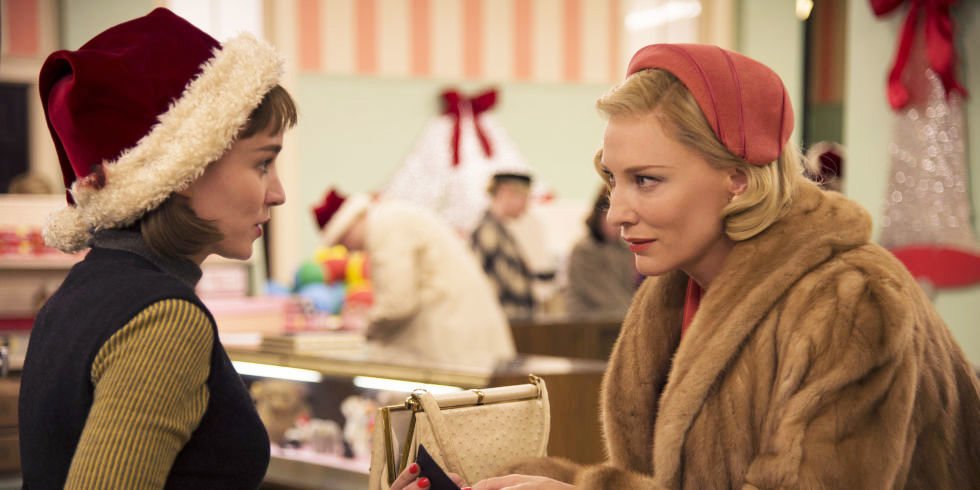‘Ostensibly an ode to the tenacity of love…’ – Daniel Palmer reviews Todd Haynes’s Carol
January 10, 2016

Carol
Todd Haynes is the great stylist of American indie cinema. But unlike many of his peers who rose under the aegis of the Weinsteins, Sundance et al. in the ’90s, Haynes’ oeuvre is imbued with a definable perspective. A ‘queer’ sensibility, a sense of otherness, runs through the barbed social psychodrama Safe (1995), the bawdy and gaudily hued glam rock saga Velvet Goldmine (1998), the sumptuous Sirkian melodrama Far from Heaven (2002) and the wilfully disjointed disquisition on the Bob Dylan mythos I’m Not There (2007).
Unlike certain other pop culture magpies and genre deconstructors, Haynes mines the past without committing the sin of nostalgia or succumbing to irony. For Haynes, the past is a template for contemporary concerns, a means of telling stories in which small transgressions challenge prevailing values. Whether in his various Dylans or Bowie facsimile or thwarted housewives, Haynes is fascinated by the ways in which outré behaviour manifests against social constraints. In Safe and Far from Heaven, Haynes takes Almodovar’s ‘woman in crisis’ and filters her through the currents of American life, as mediated through its cultural shibboleths. Carol continues this thematic thread, making it something of a companion piece.
 Based on Patricia Highsmith’s novel, The Price of Salt (1953), Carol tells the story of the unlikely romance that blossoms between Carol (Cate Blanchett), a glamorous older woman in the throes of a bitter divorce, and Therese (Rooney Mara), a detached shopgirl and aspiring photographer. Carol is a visually stunning evocation of the interregnum between the end of World War Two and the stultifying Eisenhower years; a time of prosperity and burgeoning mass consumerism, but one which engendered a strict orthodoxy embodied by the House Un-American Activities Committee. It is against this backdrop that Carol’s love story plays out.
Based on Patricia Highsmith’s novel, The Price of Salt (1953), Carol tells the story of the unlikely romance that blossoms between Carol (Cate Blanchett), a glamorous older woman in the throes of a bitter divorce, and Therese (Rooney Mara), a detached shopgirl and aspiring photographer. Carol is a visually stunning evocation of the interregnum between the end of World War Two and the stultifying Eisenhower years; a time of prosperity and burgeoning mass consumerism, but one which engendered a strict orthodoxy embodied by the House Un-American Activities Committee. It is against this backdrop that Carol’s love story plays out.
Carol evokes the tone of the period without lazy pastiche or kitschy sideswipes; its softly-lit elegance serves as a counterweight to the oppressive glare of social expectation from which Carol and Therese strain to escape. Edward Lachman’s cinematography perfectly captures the drab, drained primary colours of this period; Phyllis Nagy’s screenplay hits a sweet spot of historical and emotional authenticity; while Carter Burwell’s understated score evinces the gentle swell of longing. Haynes is a true revisionist, he is able to replicate the visual and emotional tropes of classic melodrama without emulating the genre’s thematic and structural excesses. He does not strive to offer explanations or resolutions, but to honour those who cleave to their own course, discarding what they don’t like in the face of general derision.
 It is beyond debate that Blanchett is a stunningly versatile actor, and she further underlines this here with a taut performance that brims with suppressed sensuality. Blanchett travels inwards, offering a study in circumspection which is the polar opposite of the Blanche DuBois-esque histrionics of her bravura turn in Blue Jasmine (2013). Blanchett’s face is a map of Carol’s sundry disappointments and denials. No less impressive as the Ingénue who shares in Carol’s marginalisation, Mara skilfully dramatises Theresa’s tremulous journey from grudging conformity to self-acceptance. Mara is never the junior partner here, deftly tracing Therese’s conflict, and arguably undergoing the more compelling journey of the two leads.
It is beyond debate that Blanchett is a stunningly versatile actor, and she further underlines this here with a taut performance that brims with suppressed sensuality. Blanchett travels inwards, offering a study in circumspection which is the polar opposite of the Blanche DuBois-esque histrionics of her bravura turn in Blue Jasmine (2013). Blanchett’s face is a map of Carol’s sundry disappointments and denials. No less impressive as the Ingénue who shares in Carol’s marginalisation, Mara skilfully dramatises Theresa’s tremulous journey from grudging conformity to self-acceptance. Mara is never the junior partner here, deftly tracing Therese’s conflict, and arguably undergoing the more compelling journey of the two leads.
With all the sound and fury surrounding the Bechdel test and the ongoing underrepresentation of female voices in the film industry, Carol seems incredibly timely and slyly subversive. Ostensibly an ode to the tenacity of love, Carol continues Haynes’ exploration of a parallel historical trajectory for those who fall beyond the bounds of the accepted patriarchal structures, and the depths to which this opprobrium takes them. Haynes has once again succeeded in creating a work which is at turns classical and strikingly modern.
Filed under: Film, TV & Tech
Tagged with: bechdel test, Carol, Cate Blanchett, Rooney Mara, Sheffield, Todd Haynes



Comments